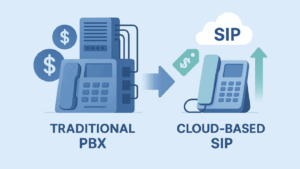
Is SIP Trunking Your Best Business Phone Solution?
Today’s businesses are under pressure to be profitable due to rising technology costs. To reduce expenses, many business owners are upgrading legacy landline phone systems to next-generation digital solutions such as Voice Over IP (VoIP) with Session Initiation Protocol (SIP) trunking.
A 2022 market survey reveals that businesses are reporting a 90% reduction in initial costs with VoIP. In this blog, we’ll take a closer look at how SIP trunking is changing the scope of telecommunications and how this technology may be the best phone solution for your business.
Legacy Phone Systems Versus SIP Trunking
Digital transformation has resulted in the development of innovative technologies that enable us to communicate more efficiently than ever before. However, many businesses are still utilizing legacy copper-wire-based telephone systems that are inefficient and costly to maintain. This is no surprise, given that this system has existed since the late 1800s.
The traditional landline system utilizes a Public Switched Telephone Network (PSTN) to connect calls. The voice signal is converted into an electrical signal and sent through the copper wires to the PSTN. The PSTN connects to the Private Branch Exchange (PBX), the telephone network used within the organization that enables users to communicate via internal lines and make and receive external calls.
Today’s digital phone services use Voice over Internet Protocol (VoIP) to carry voice signals over the internet. SIP is an open-source protocol that allows the initiation, maintenance, and termination of phone calls between devices on the VoIP network. These systems require a SIP trunk, a hardware component that enables devices to connect to the internet. The trunk can either be hosted at a nearby data center or installed as part of the business’s internal network.
The High Price of Maintaining a Legacy Phone System
For several reasons, legacy copper-wire telephony systems are considerably more expensive for businesses.
- They often require many components, which are costly to purchase and maintain.
Landlines carry a hefty monthly price tag, with a single primary line running as high as $85 a month. There are also environmental costs as legacy systems consume more power. Additionally, staff with specialized skills or outside consultants are needed to oversee the legacy system, adding to the already high maintenance expenses. - Legacy phone systems are difficult to scale up or down as the needs of the business change.
These systems are not readily adaptable to changes. Because of this, businesses must either continue using an outdated system or pay an exorbitant amount of money to upgrade. This presents a significant challenge for growing businesses, as they may not have the budget to accommodate their changing needs. - Your business is more prone to costly cyber-attacks
Legacy phone systems are not as well protected and have more vulnerabilities that attackers can easily exploit. Additionally, legacy systems are often incompatible with newer security technologies, making it more difficult to defend against attacks. Finally, businesses with legacy phone systems often have fewer employees who are not as familiar with modern security practices, presenting greater opportunities for attackers to trick them into divulging sensitive information or installing malware. Regardless of how it occurs, the security breach can cost your business thousands of dollars in lost productivity and damages.
How SIP Trunking Enhances Business Communication
SIP trunking is an ideal solution for businesses seeking greater efficiency, flexibility, and scalability in their communications systems. Companies ranging from small businesses to large enterprises are taking advantage of SIP trunking since the technology offers the following benefits:
Call transparency
SIP trunking allows businesses to monitor call activity and usage patterns and track customers’ interactions with the company. This information can be used to optimize customer service or identify areas for improvement.
Increased call efficiency
By consolidating multiple communication channels into a single connection, SIP trunking can reduce network congestion and help improve call quality. Calls route through a proxy server, which forwards the call to its destination.
The advantage of this system is that it allows numerous SIP clients to connect to the same proxy server, reducing the need for each client to maintain its SIP connection. It also increases the efficiency of call processing. There are no delayed or lost calls from overloaded exchanges during peak call periods.
Additionally, since SIP routes the calls using predetermined rules, the network knows where to route calls based on the caller’s input and the current network state.
A connected workforce from any location
Since SIP can be used to connect remote workers and branch offices, employee communications are improved. SIP also allows video and text transmission to provide alternate and enhanced communications.
All SIP calls use the internet for routing, meaning that employees can be located anywhere in the world and still be able to communicate with each other. This is a valuable feature for businesses with employees often out of the office, such as sales or field services teams. SIP trunking can also be used to connect multiple offices so that employees can easily collaborate no matter where they are located.
Productive new features
SIP includes various features that can be tailored to meet your business’s needs. For example, you can use SIP to create custom applications, integrate with third-party software, or develop custom solutions.
By using SIP, businesses can take advantage of several features designed to improve communication, including call forwarding, caller ID, voicemail, and call waiting. In addition, SIP can be used to establish conference calls and video calls, making it an ideal solution for businesses that need to collaborate on projects or share information in real-time.
Enhanced security
SIP trunking can be configured to use Transport Layer Security (TLS) encryption for all signaling and media traffic. In addition, SIP trunking can be used with Secure Real-time Transport Protocol (SRTP) or Session Description Protocol (SDES), two powerful mechanisms that encrypt media traffic. These security protocols help to prevent eavesdropping and ensure the privacy of communications. In addition, SIP trunking can be integrated with firewalls and intrusion detection/prevention systems to provide an additional layer of security. As a result, SIP trunking can provide a high level of protection for voice communications.
Superior quality audio
SIP supports a variety of codecs (coder-decoders) which allows for clear and efficient communication. SIP also uses less bandwidth than other VoIP protocols, increasing audio quality. SIP uses Real-time Transport Control Protocol (RTCP) for connections, reducing latency and jitter.
Related: SIP: Benefits for Business Communications
SIP Trunking Facilitates Improved Customer Service
With increasing online and global competition, businesses need to find ways to stand out from the crowd. Call centers that utilize SIP trunking technology provide efficient customer service in several ways, including:
- Rules can be established in the network to direct incoming calls to available agents. If agents are busy, customers are directed to an inbox to leave a message. This is especially useful during peak call times.
- Call response times are decreased since automatic routing rules can equally distribute calls to all agents. Additionally, the digital systems have features that enable agents to quickly contact their supervisors to solve complicated queries.
- Agents can work remotely, allowing managers to recruit the best talent in any location.
- Calls can be recorded for analysis for agents in training to better serve customers.
- Common queries such as account balances and status can be automated to help customers needing this simple information.
Related: Why Use VoIP for Business in 2022
How SIP Trunking can be a Cost-Effective Solution for Your Business
As the business world becomes increasingly competitive, companies are always searching for ways to cut costs and improve efficiency. By migrating to a SIP trunking telephony solution, businesses cut costs in the following ways:
- SIP trunking consolidates your telecommunications network
Converging voice, video, and data in a single digital system eliminates redundant cable, T1, or Ethernet connections, resulting in the elimination of costly monthly subscription plans. - Company-wide extension dialing plans with free interoffice calling
Businesses only need one main phone number and then extensions for each employee. - Elimination of expensive long-distance charges
SIP eliminates the expensive per-minute local and long-distance charges. Instead, businesses pay the same monthly amount per channel. - No overpayment for unused lines
With traditional phone systems, companies pay for a package of 23 voice channels, whether they are all needed or not. However, SIP channels can be purchased as necessary to support one incoming or outgoing call. - Long-term contracts are eliminated
SIP agreements can be made month-to-month, allowing businesses the freedom to transfer to another service. This eliminates costly penalties for canceling long-term contracts with traditional phone carriers.
Integrate SIP Trunking into Your Communications Today
SIP trunking is a cost-effective telephony solution that can improve your business’s productivity, customer service, and overall efficiency.
Unlike cumbersome and outdated legacy phone systems, SIP streamlines many communication functions and provides a wealth of features for businesses. From more flexibility and scalability to higher quality audio and reduced maintenance costs, SIP trunking can meet the communications needs of businesses of every size.
We can upgrade your legacy phone system to a SIP trunking network that will save your business time and money while improving productivity. Contact us today to learn how easy it is to modernize your communications with SIP.US.


